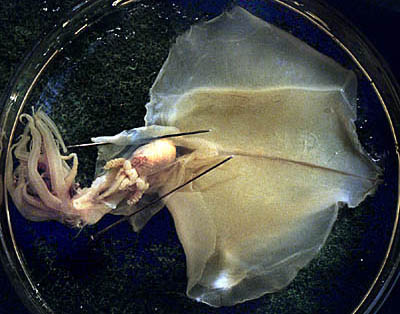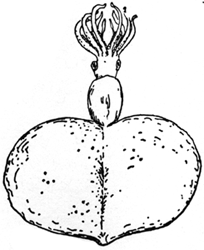Magnapinna sp. C
Michael Vecchione and Richard E. YoungIntroduction
A magnapinnid, illustrated by Hardy (1956) from the South Atlantic and identified as Octopodoteuthopsis, is deposited in the Natural History Museum, London (BMNH). This squid was not recognized as a magnapinnid prior to the work of Vecchione and Young (submitted) due to the slender tentacles which differed greatly from the previously only known species, M. pacifica.
Diagnosis
A Magnapinna ...
- with proximal-tentacles more slender than arms IV.
- with pigment in chromatophores.
- without "white nodules" on fins or glandular regions on proximal-tentacles.
Characteristics
- Arms
- Proximal-arms approximately subequal in length (ca 40-45% of ML).
- Proximal-arms with gelatinous consistency and thick protective membranes.
- Arm tips stripped and damaged, distal-arms not recognizable.
- Proximal-arm suckers closely spaced, in 2 series.
- Proximal-arm suckers globular with smooth rings.
- Tentacles
- Tentacles badly damaged, suckers absent.
- Tentacle diameter at base less than arm diameter.
 image info
image info Figure. Lateral view of the head, arms and tentacles of Magnapinna sp. C showing funnel locking apparatus. Photograph by Wen-Sung Chung.
- Funnel
- Funnel locking-apparatus oval, without tragus or antitragus.
- Funnel locking-apparatus oval, without tragus or antitragus.
- Mantle
- Mantle length 79 mm.
- Mantle length 79 mm.
- Fins
- Fin length 59 mm (75% of ML); width 76 mm.
- Fins in terminal position.
- Fins attach to lateral sides of gladius.
- "White nodules" absent from fins.
- Photophores
- Photophores absent.
- Viscera
- Spermatophore glands present.
Comments
We examined the specimen in the year 2000 before we realized that it belongs to the Magnapinnidae. The brief description above is from some notes we made at the time. The arms and tentacles were badly damaged in capture. The squid is an immature male. The buccal mass is relatively large and the buccal membrane is very reduced.
Magnapinna sp. C is similar to the three other Atlantic specimens of Magnapinna in the presence of slender proximal tentacles and two series of suckers on the arms. It is further similar to Magnapinna sp. A and M. talismani in the possession of scattered large chromatophores. In addition to other characters, it differs (1) from Magnapinna sp. C in lacking glandular regions on the tentacles, (2) from M. talismani in the lack of fin nodules and (3) from Magnapinna sp. A in the presence of large chromatophores.
References
Vecchione, M., Young R. E. Submitted. The squid family Magnapinnidae (Mollusca; Cephalopoda) in the North Atlantic with a description of a new species.
Title Illustrations
| Scientific Name | Magnapinna sp. C |
|---|---|
| Location | South Atlantic |
| Specimen Condition | Dead Specimen |
| Sex | Male |
| View | Ventral |
| Copyright | © Wen-Sung Chung |
About This Page
National Marine Fisheries Service
Systematics Laboratory
National Museum of Natural History
Washington, D. C. 20560
USA
Richard E. Young
Dept of Oceanography
University of Hawaii
Honolulu, Hawaii 96822
USA
Page copyright © 2005 and Richard E. Young
- First online 16 August 2005
Citing this page:
Vecchione, Michael and Young, Richard E. 2005. Magnapinna sp. C. Version 16 August 2005 (under construction). http://tolweb.org/Magnapinna_sp._C/52211/2005.08.16 in The Tree of Life Web Project, http://tolweb.org/











